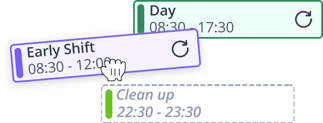Want to understand how an HR dashboard can improve decision-making and streamline your HR processes? This guide breaks down everything HR managers and employers need to know; metrics, tools, benefits, and best practices.
What is an HR dashboard?
An HR dashboard is a business intelligence tool that gives HR teams a clear, centralised view of their workforce data. It helps track, analyse, and report on key performance indicators (KPIs) and HR metrics that matter most to human resources departments; everything from employee turnover and average salary to recruitment process stats and employee satisfaction scores.
By combining data from various sources like payroll, attendance systems, and recruitment platforms, an HR dashboard turns raw information into actionable insights.
Key components of an effective HR dashboard
A well-designed dashboard tells a story about your company’s workforce and helps you act on it.
Essential metrics
Not all data is created equal. A powerful HR dashboard focuses on high-value, critical metrics that reflect the health of your workforce. These KPIs provide a better understanding of how your organisation is performing and where improvements are needed.
Here are the key metrics every dashboard should include:
|
Metric |
Why It Matters |
|---|---|
|
Turnover rates |
Helps assess retention strategies and spot workforce trends. |
|
Time-to-hire |
Measures recruitment process efficiency and hiring bottlenecks. |
|
Employee satisfaction score |
Tracks how content and engaged employees are with their work environment. |
|
Diversity metrics |
Offers insight into workforce diversity, equity, and inclusion efforts. |
|
New hires vs total employees |
Shows workforce growth and hiring trends over time. |
|
Pay equity and average salary |
Assists in maintaining fair compensation across roles and demographics. |
|
Employee performance data |
Supports talent development by identifying top performers and those needing support. |
|
Active employees |
Gives a real-time snapshot of current workforce size. |
|
Workforce demographics |
Breaks down the makeup of your team by age, gender, role, location, etc. |
|
Employee safety reports |
Helps track incidents and supports compliance with safety standards. |
A recruitment dashboard or employee performance dashboard might prioritise some metrics more than others, depending on the focus.
Data visualisation
Presenting data well is just as important as collecting it. HR dashboards use visual tools like pie charts, bar graphs, line charts, and heat maps to make complex data easy to understand at a glance.
Why visualisation matters:
-
Makes trends visible for quicker decision-making.
-
Helps non-technical stakeholders grasp complex information.
-
Reduces time spent analysing data manually.
-
Supports regular reporting by making reports easy to share and read.
For example, a diversity dashboard might use pie charts to display gender or ethnic distribution, while a turnover data heat map can highlight departments with high employee turnover.
Customisation and interactivity
A one-size-fits-all dashboard rarely works. HR leaders, executives, and team managers need different views of the data. That’s where customisation and fully interactive dashboards come in.
Key features to consider:
-
Role-based views: Executive HR dashboards may highlight high-level metrics, while recruiters might need detailed views of hiring trends.
-
Filter options: Allow users to break down data by department, location, date range, or job title.
-
Drill-down capability: Enable users to click through top-level figures to explore the underlying data.
-
Custom widgets: Choose which modules to display based on departmental needs.
-
Real-time insights: Keep dashboards updated automatically to reflect the latest information.
By allowing users to tailor their dashboards, HR management can offer insights that are not only relevant but immediately useful, turning data into decisions.
Types of HR dashboards
Different challenges need different tools and the right type of HR dashboard can make all the difference. Whether you're monitoring daily HR tasks or planning for the next five years, there's a dashboard to match your needs.
Operational dashboards
These dashboards are the frontline of HR management, designed to support everyday tasks and give HR teams a quick way to keep things running smoothly. Think of them as your daily check-in.
Typical uses:
-
Attendance tracking – Monitor punctuality, absenteeism, and active employees.
-
Leave management – Track holiday balances, sick leave trends, and leave approvals.
-
New employees – See who’s joining soon, onboarding progress, and probation status.
-
Workforce data – View current headcount, employee demographics, and department allocation.
Operational dashboards offer real-time insights for quick decision making and are ideal for individual contributors or managers handling day-to-day workforce operations.
|
Focus Area |
Metrics Tracked |
User Role |
|---|---|---|
|
Attendance |
Absences, lateness, scheduled hours |
Team leads, supervisors |
|
Leave |
Sick days, holiday taken, leave requests |
HR professionals |
|
Headcount status |
Total employees, new hires, exits |
Workplace management |
Strategic dashboards
When HR leaders and executive HR stakeholders want to align workforce planning with business growth, they turn to strategic dashboards. These dashboards connect the dots between HR data and long-term business goals.
What they provide:
-
Workforce trends – Understand hiring patterns, growth projections, and turnover rates.
-
Talent development – Monitor training participation, skill gaps, and succession planning.
-
Recruitment process health – Track pipeline status, source effectiveness, and cost per hire.
-
Retention strategies – Analyse why employees leave and how to improve employee satisfaction.
Strategic dashboards support informed decisions by helping HR managers combine data from various departments and track progress over time.
|
Strategic Focus |
Examples of KPIs |
|---|---|
|
Recruitment strategy |
Time-to-hire, source effectiveness, offer acceptance rate |
|
Talent development |
Course completion rates, internal promotions |
|
Workforce planning |
Headcount forecasts, turnover data trends |
Analytical dashboards
These are the most advanced type of HR dashboard examples designed not just to show what’s happening but why, and what might happen next. Built with tools like Power BI or other data analysis platforms, they’re perfect for digging deep into patterns and providing actionable insights.
Key features:
-
Predictive analytics – Spot trends before they become problems (e.g. likely resignations).
-
Workforce diversity analysis – Monitor gender balance, ethnicity, and other key diversity indicators.
-
Pay equity and compensation trends – Identify gaps by comparing average salary data across roles.
-
Sentiment analysis – Use survey results to understand employee satisfaction in more detail.
Analytical dashboards help HR executives and data-driven teams go beyond surface-level reporting to build smarter retention strategies and refine their HR processes.
|
Analytical Feature |
Value |
|---|---|
|
Predictive modelling |
Forecast turnover, hiring needs, skill shortages |
|
Trend tracking |
Visualise patterns in absenteeism or performance |
|
Deep segmentation |
Analyse data by gender, role, department, tenure |
Each type of dashboard helps the human resources department approach workforce challenges from a different angle; whether it’s managing more employees, evaluating performance, or enhancing long-term planning.
Benefits of implementing HR dashboards
A well-built HR dashboard does more than just display numbers; it helps HR teams take meaningful action faster, with fewer mistakes and better outcomes across the business.
Enhanced decision-making
Real-time data means no more guesswork. HR dashboards provide informed decisions by turning live workforce data into clearly visualised metrics.
How this helps:
-
Spot turnover spikes early and act fast with retention strategies.
-
Adjust recruitment plans based on accurate employee turnover and new hires data.
-
Quickly review hiring bottlenecks or rising absenteeism.
For example, a recruitment dashboard showing rising time-to-hire in a specific department allows HR managers to intervene before productivity drops.
Improved efficiency
Manual data collection is time-consuming and prone to error. Dashboards solve this by automating data pulling and reporting, streamlining repetitive tasks.
Efficiency gains include:
-
Faster HR report creation for meetings or audits.
-
Less manual input = fewer errors in turnover rates or payroll metrics.
-
More time for high-impact projects like training or workforce planning.
Increased transparency
When key metrics are accessible, everyone is on the same page. Dashboards make HR data visible to stakeholders, whether it’s team leads, executive HR, or board members.
Why this matters:
-
Clear tracking of employee performance, attendance, or diversity goals.
-
Promotes accountability across departments.
-
Helps align HR actions with company-wide goals.
Challenges and considerations
While HR dashboards offer big advantages, they’re only effective when implemented thoughtfully. Here’s what to keep in mind before you start building or buying.
Data quality and integration
A dashboard is only as good as the data behind it. Pulling in inconsistent or outdated information will skew your insights.
Common challenges:
-
Incompatible data sources (e.g. HRIS, payroll, ATS) make it hard to combine data.
-
Duplicate or missing records distort high-level metrics.
-
Lack of standard definitions for metrics like “turnover” or “active employees.”
💡Tip: Prioritise systems that integrate easily and define each metric clearly from day one.
User adoption
Even the best dashboard won’t deliver value if no one uses it. Rolling out a new system requires change management and support.
What to consider:
-
Provide hands-on training for HR teams, department heads, and HR executives.
-
Make dashboards fully interactive and user-friendly; no technical skills required.
-
Start with HR dashboard examples tailored to actual workflows.
Privacy and compliance
With more employee demographics, performance data, and pay details being analysed, privacy must be a top priority.
Risks to manage:
-
Breaches of confidential data (e.g. health, gender, or salary).
-
Non-compliance with GDPR or local labour laws.
-
Overexposure of individual-level data in employee performance dashboards.
Solutions:
-
Limit access by user role.
-
Mask or anonymise sensitive fields.
-
Ensure all systems comply with current data protection standards.
Best practices for designing HR dashboards
A dashboard isn’t just a data display—it’s a decision-making tool. To make it effective, it needs to be purposeful, clean, and constantly evolving.
Align with organisational goals
Your HR dashboard should reflect what the company is actually trying to achieve. That means connecting key performance indicators directly to the wider business strategy.
Examples:
-
If reducing turnover is a priority, track employee turnover, retention strategies, and employee satisfaction scores.
-
If you’re focused on inclusion, prioritise metrics on workforce diversity, gender balance, and pay equity.
-
For growth goals, monitor new hires, total employees, and recruitment funnel performance.
Keep it simple and focused
The most effective dashboards are easy to read, not packed with every number under the sun. Too much data can confuse rather than clarify.
Tips for clarity:
-
Use limited colour schemes, consistent icons, and clear labelling.
-
Display critical metrics only; avoid cluttering with “nice-to-have” figures.
-
Prioritise visual elements like pie charts, line graphs, and gauges to highlight high level metrics.
Regularly update and review
An outdated dashboard is worse than no dashboard. It gives a false sense of accuracy.
Make it a habit to:
-
Schedule regular reviews (monthly or quarterly) of metrics, layouts, and user access.
-
Adjust visuals as company priorities evolve.
-
Collect user feedback to improve usefulness and usability.




